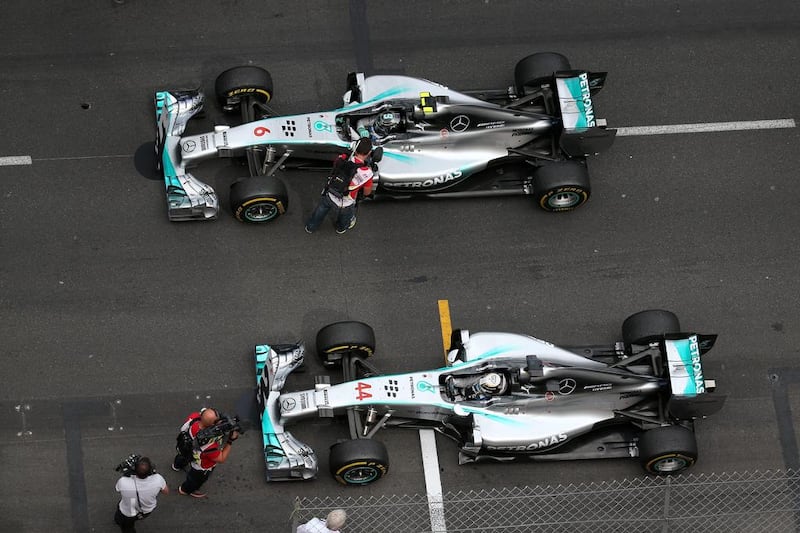It seemed appropriate that Mercedes-GP bosses reportedly reached out to Alain Prost ahead of Sunday’s Monaco Grand Prix to seek his advice in maintaining peace between their driver pairing of Lewis Hamilton and Nico Rosberg.
The four-time world champion is better placed than most to know the subject well, having been teammates with Ayrton Senna at McLaren between 1988-89.
McLaren was then the dominant force in Formula One and, in the 32 races they raced as a pair, they won 25 times – Senna having 14 victories to Prost’s 11.
But that does not tell the story of the volatile nature of the partnership, which saw team orders ignored, arguments, accusations of favouritism and ultimately a collision at the 1989 Japanese Grand Prix.
Senna took the 1988 title, Prost the 1989 one, but, despite the success, the period is still seen as the greatest example of why things do not usually end well when you have two No 1 drivers in the same team.
Similarities are already being drawn between that era and what is going on between Hamilton and Rosberg, and that is accurate.
Senna had the greater raw pace, which was backed up by his 26 pole positions in his two years with Prost, but he did not quite have the same ability as Prost to set up a car well.
Prost’s nickname was “the Professor”, because of his ability to work diligently and get a car set up perfectly for a race distance.
Doing a quick lap once is a skill, but keeping a car well balanced on wearing tyres and contrasting fuel loads is an art, and one that Prost mastered.
There is a strong element of Prost in Rosberg, while Hamilton’s speed is reminiscent of Senna.
The score in both qualifying and race wins so far this season is 4-2 to Hamilton, despite the fact that it is Rosberg who tops the championship by four points following his win in Monte Carlo on Sunday. Hamilton, the 2008 world champion, has been perceived as the fastest man in F1 over a single lap, but his ability to set-up a car is more inconsistent.
When he has had the F1 WO5 chassis hooked up, such as in Malaysia, he could not be caught.
In Bahrain and Spain it was Rosberg who was quicker on race day, but strong defensive driving and track advantage meant Hamilton triumphed when he was not the fastest man on the day, something he acknowledged.
So the characteristics are similar and history is repeating itself in terms of the animosity slowly rising between the pair.
The catalyst for this in Monaco was when Rosberg ran off down an escape road on Turn 5 on his final qualifying lap, which brought caution flags out to slow down all following drivers.
That included Hamilton, who was unable to complete his final lap, which denied him the chance to challenge Rosberg, who had the fastest time when the incident happened.
You did not need to be a body language expert to see that Hamilton did not buy Rosberg’s driving as a mistake and the stewards investigated the German’s driving, checking his telemetry.
Any sympathy for Hamilton was lost thanks to his sulky behaviour and consistent complaining over the team radio as he sat behind his teammate for 78 laps, which were, frankly, embarrassing at times.
His ire came from pure frustration as he knew his winning chances were realistically gone the moment he saw the yellow flags on the way down to Turn 5.
Pole position is the be all and end all in Monaco at a track where overtaking is almost impossible, unless the driver in front makes a mistake, and once Rosberg had got the lead at the start it was effectively game over.
Hamilton clearly felt wronged by Rosberg and the unsubtle references to having driven “fairly” all weekend fooled no one.
He has a history of emotional reactions when he thinks things have gone against him and how quickly he can refocus could be key to his championship hopes.
Rosberg is a more relaxed character although, until Hamilton, he had rarely been beaten regularly by a teammate, other than in his first season in F1 in 2006 when he was up against Mark Webber.
This is new territory for him and his Monaco performance – qualifying mistake apart – was very impressive, given the atmosphere and the pressure Hamilton put him under for the majority of the race distance.
The tension is unlikely to lessen any time soon, given that only one of them can leave Abu Dhabi on November 23 as world champion, a certainty given how fast the Mercedes car is compared to the rest of the field.
The bad feeling is not good news for Mercedes bosses but it is great for the public and things are only going to get more interesting.
gcaygill@thenational.ae





